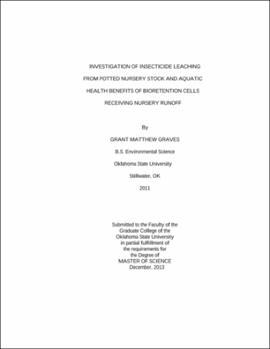| dc.description.abstract | Tree nurseries and greenhouses within the USDA red imported fire ant (RIFA) quarantine zone are required to incorporate insecticides into their potting media to prevent artificial spread of RIFA. Bifenthrin and fipronil are two common insecticides that are incorporated into potting media. During irrigation and stormwater events, there is potential for insecticides to leach from nursery pots, resulting in contamination of nearby surface waters. In this study, occurrences of insecticides in simulated nursery runoff were compared for two irrigation strategies and two types of containers in single pot leaching and field runoff simulations. In addition, toxicity of pot leachate to the aquatic invertebrate, Hyallela azteca, was measured, and removal efficiencies of insecticides from bioretention cell media were evaluated. Overhead irrigation resulted in significantly higher concentrations than drip irrigation, and Root Maker pots allowed more leaching as compared to standard slick-wall pots. However, in all tests, the average concentration of bifenthrin during 15 days of leaching in both pot and field simulations was greater than 200 ng/L - more than 100-fold greater than the LC_50 for H. azteca. Toxicity studies confirmed this level of toxicity. Higher amounts of compost, 20% and 40%, in bioretention cell media resulted in greater percent reduction of both bifenthrin and fipronil. This study determined that management techniques may be able to limit the amount of insecticide that leaches from pots and runs off to receiving water bodies. Specifically, selection of appropriate pot types, irrigation strategies, or filtering runoff through bioretention cells that may reduce contamination loads. Thus, further best management strategies such as use of bioretention cells are needed in nursery and greenhouse facilities to prevent surface water runoff from transporting toxic insecticides to nearby water bodies. | |
